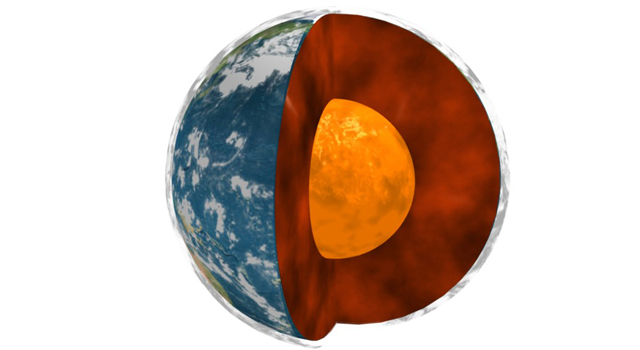The Earth's core has changed shape and rotation in recent decades
A study in 2024 described how the Earth's core had slowed down its rotation speed in recent decades. Now, the same international team of scientists adds that its shape has also changed over the last two decades. Until now, it was thought that both processes could not occur simultaneously. According to the researchers, who publish the results in the journal Nature Geoscience, the finding could improve our knowledge of the core's properties and structure.

Maurizio Mattesini - nucleo forma EN
Maurizio Mattesini
Catedrático de Geofísica
There is no doubt that the centre of the Earth is one of the most mysterious and inaccessible places on the planet. Formed more than a billion years ago, the inner core is a solid sphere with a radius of 1,220 km, located exactly at the centre of our planet and formed from the crystallisation of iron from the liquid outer core. The inner core is the hottest place on our planet, with a temperature of between 6,000 and 7,000 ºC, even higher than the temperature of the Sun's surface. In addition, the pressure is extremely high, reaching approximately 3.5 million atmospheres. Understanding how it evolves (grows in size and rotates) over time is of vital importance for predicting the geodynamics of our planet. The Earth's solid inner core plays an important role in maintaining the planet's magnetic field, as its growth (about 0.5 mm/year) is the main driver of convection in the liquid outer core. Furthermore, many aspects of the Earth's surface are affected by the complex flow of heat from the inner core to the surface. One of the main functions of the inner core is to generate the Earth's magnetic field and to enhance plate tectonics, both of which are fundamental to life on Earth and other terrestrial planets.
The study published in Nature Geoscience is very interesting because it provides scientific evidence of changes in the shape of the Earth's inner core over the last two decades. These changes appear to be localised near the surface of the inner core and could improve our understanding of its properties and structure. It is important to emphasise that previous research had already proposed that the inner core had undergone changes in its rotation or in its shape over time, but not both simultaneously. Until now, it was known that, around the year 2010, the inner core went from rotating faster to rotating slower than the rest of the Earth.
The technique used is well known in seismology and consists of analysing the seismic waves generated by pairs of earthquakes, commonly called ‘doublets’. These are earthquakes that occur years apart but share the same hypocentre and focal mechanism, and whose waves are recorded at the same stations on the Earth's surface. Using this technique, any change in the waveform or travel times allows seismologists to detect possible variations in the speed of rotation and the shape of the inner core.
John Vidale, from the University of Southern California (USA), and his colleagues have analysed the waveform and travel times of seismic waves recorded at the Eielson and Yellowknife arrays in the USA, generated by earthquakes in the South Sandwich Islands before and after 2010. As some of these earthquakes occurred when the inner core had returned to the same relative position with respect to the rest of the Earth (2010), not all the differences observed in the seismic waves within each doublet can be attributed only to variations in the rate of rotation. The authors found that the seismic waves from earthquakes that passed through the inner core are consistent with each other, while those that only grazed it show differences. The study concludes that this could be explained by temporal changes in the shape of the inner core. The authors suggest that this process is probably the result of the pull exerted by density anomalies in the lowest part of the mantle or of the drag caused by convective flow in the outer core, although they point out that more research is needed to provide a definitive explanation.
Although they have not been able to quantify the size of the deformation of the inner core, this work shows that there can be simultaneous changes in its rotation and shape, the latter being an aspect that deserves much more detailed investigation. A deeper analysis of the anomalies in the shape of the inner core could lead to a rewriting of the multi-decadal history of its differential rotation with respect to the rest of the Earth.
Vidale et al.
- Research article
- Peer reviewed



